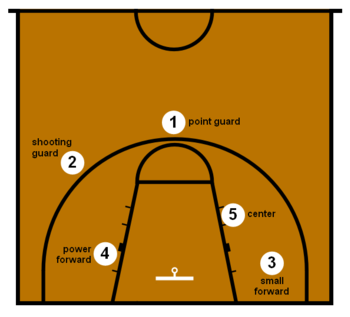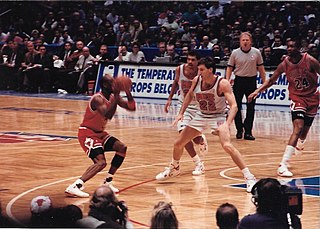
Basketball is a team sport in which two teams, most commonly of five players each, opposing one another on a rectangular court, compete with the primary objective of shooting a basketball through the defender's hoop, while preventing the opposing team from shooting through their own hoop. A field goal is worth two points, unless made from behind the three-point line, when it is worth three. After a foul, timed play stops and the player fouled or designated to shoot a technical foul is given one, two or three one-point free throws. The team with the most points at the end of the game wins, but if regulation play expires with the score tied, an additional period of play (overtime) is mandated.

The power forward (PF), also known as the four, is one of the five traditional positions in a regulation basketball game. Traditionally, power forwards have played a role similar to centers and are typically the second tallest player on the court. When on offense, they typically play with their backs towards the basket. When on defense, they typically position themselves under the basket in a zone defense or against the opposing power forward in man-to-man defense. The power forward position entails a variety of responsibilities, including rebounding, screen setting, rim protecting, and scoring.
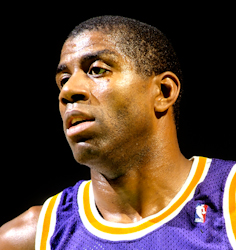
The point guard (PG), also called the one or the point, is one of the five positions in a regulation basketball game. A point guard has perhaps the most specialized role of any position and is usually the shortest player on the court. Point guards are expected to run the team's offense by controlling the ball and making sure that it gets to the right player at the right time. Above all, the point guard must understand and accept their coach's game plan; in this way, the position can be compared to the position of quarterback in gridiron football. They must also be able to adapt to what the defense is allowing and must control the pace of the game.
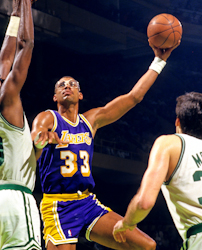
The center (C), or the centre, also known as the five or the pivot, is one of the five positions in a regulation basketball game. The center is almost always the tallest player on the team, and often has a great deal of strength and body mass as well. In the NBA, the center is typically close to 7 feet (2.13 m) tall; centers in the WNBA are typically above 6 feet 4 inches (1.93 m). Centers traditionally play close to the basket in the low post. The two tallest players in NBA history, Manute Bol and Gheorghe Mureșan, were both centers, each standing 7 feet 7 inches (2.31 m) tall.

In basketball, the basketball court is the playing surface, consisting of a rectangular floor, with baskets at each end. Indoor basketball courts are almost always made of polished wood, usually maple, with 3.048 meters (10 ft)-high rims on each basket. Outdoor surfaces are generally made from standard paving materials such as concrete or asphalt. International competitions may use glass basketball courts.

The shooting guard (SG), also known as the two, two guard or off guard, is one of the five traditional positions in a regulation basketball game. A shooting guard's main objective is to score points for their team and steal the ball on defense. Some teams ask their shooting guards to bring up the ball as well; these players are known colloquially as combo guards. A player who can switch between playing shooting guard and small forward is known as a swingman. In the NBA, shooting guards usually range from 6 ft 3 in (1.91 m) to 6 ft 7 in (2.01 m) while in the WNBA, shooting guards tend to be between 5 ft 10 in (1.78 m) and 6 ft 1 in (1.85 m).

The small forward (SF), also known as the three, is one of the five positions in a regulation basketball game. Small forwards are typically shorter, quicker, and leaner than power forwards and centers but taller, larger, and stronger than either of the guard positions. They are strategic and are often relied upon to score, defend, create open lanes, and rebound for their team.
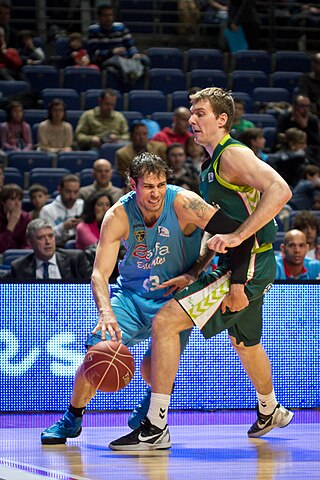
In basketball, a personal foul is a breach of the rules that concerns illegal personal contact with an opponent. It is the most common type of foul in basketball. A player fouls out on reaching a limit on personal fouls for the game and is disqualified from participation in the remainder of the game.

The rules of basketball are the rules and regulations that govern the play, officiating, equipment and procedures of basketball. While many of the basic rules are uniform throughout the world, variations do exist. Most leagues or governing bodies in North America, the most important of which are the National Basketball Association and NCAA, formulate their own rules. In addition, the Technical Commission of the International Basketball Federation (FIBA) determines rules for international play; most leagues outside North America use the complete FIBA ruleset.
Box-and-one defense is a type of defense used in basketball. The box-and-one defense is a hybrid between a man-to-man defense and a zone defense.
Basketball moves are generally individual actions used by players in basketball to pass by defenders to gain access to the basket or to get a pass to a teammate to score.
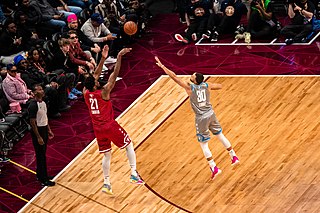
A three-point field goal is a field goal in a basketball game made from beyond the three-point line, a designated arc surrounding the basket. A successful attempt is worth three points, in contrast to the two points awarded for field goals made within the three-point line and the one point for each made free throw.

This glossary of basketball terms is a list of definitions of terms used in the game of basketball. Like any other major sport, basketball features its own extensive vocabulary of unique words and phrases used by players, coaches, sports journalists, commentators, and fans.
Variations of basketball are games or activities based on, or similar in origin to, the game of basketball, in which the player utilizes common basketball skills. Some are essentially identical to basketball, with only minor rules changes, while others are more distant and arguably not simple variations but distinct games. Other variations include children's games, contests or activities intended to help the player practice or reinforce skills, which may or may not have a competitive aspect. Most of the variations are played in informal settings, without the presence of referees or other officials and sometimes without strict adherence to official game rules.
Nellie Ball is an offensive strategy in basketball developed by NBA head coach Don "Nellie" Nelson. It is a fast-paced run-and-gun offense relying on smaller, more athletic players who can create mismatches by outrunning their opponents. A true center is usually not needed to run this type of offense. A large volume of three-point attempts is also a feature of Nellie Ball. This offense is most effective against teams that do not have the athleticism or shooting ability to keep up with the fast pace.
In basketball, small ball is a style of play that sacrifices height, physical strength and low post offense/defense in favor of a lineup of smaller players for speed, agility and increased scoring. It is closely tied to the concepts of pace and space, which pushes the speed of the offense and spreads out the defense with extra shooters on the court. Many small ball lineups feature a non-traditional center who offers skills that are not normally found from players at that position. Teams often move a physically dominant player who would typically play the small forward position into the power forward position. Examples of players who have been used in this role include Kevin Durant, Carmelo Anthony, and LeBron James. That individual would play alongside either a traditional power forward, or alongside a center.

The 2–3 zone defense is a defensive strategy used in basketball as an alternative to man-to-man defense. It is referred to as the 2–3 because of its formation on the court, which consists of two players at the front of the defense and three players behind.

In basketball, a stretch four (sometimes called a stretch big) is a player at the power forward position that can shoot farther from the basket than a conventional power forward. "Stretch" describes the effect that such a player has on the opposition's defense, and the power forward position is also known as the "four"; hence "stretch four". The stretch four is a fairly recent innovation in the NBA, but is still becoming increasingly common in today's game, as many NBA coaches now use the "small-ball" line-up/tactical play.
Basketball is a ball game and team sport in which two teams of five players try to score points by throwing or "shooting" a ball through the top of a basketball hoop while following a set of rules. Since being developed by James Naismith as a non-contact game that almost anyone can play, basketball has undergone many different rule variations, eventually evolving into the NBA-style game known today. Basketball is one of the most popular and widely viewed sports in the world.
